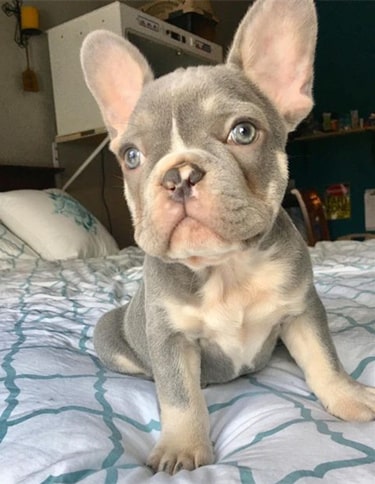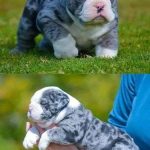French Bulldogs are among the breeds with limited coat colors. If you take a look at the breed standards, you know there are only four accepted colors: brindle, brindle with white, fawn, and white. In today’s post, we will put an emphasis on one color that is considered to be rare, the lilac French bulldog color.

Lilac French Bulldog Origin
In canine genetics, the lilac french bulldog is also known as Isabella french bulldog. This coat color is achieved when a liver or chocolate-colored dog is paired with another dog possessing the blue DNA. The offspring is born with two copies of the d allele and displays a diluted coat color.
Isabella is caused by the same gene that is responsible for making a black dog turn blue. However, there are more blue dogs than lilac ones. As the result of a recessive gene, you will rarely see dogs possessing the dilute liver or Isabella color.
There are DNA tests already available to confirm if a dog has “d”genes. Dogs with such a color may have a parent with a “b” gene. If you want to learn more about your French bulldog’s coloring, you may send samples of your pet’s cheek swab or blood samples to animal testing centers.
Appearance
A lilac French Bulldog is known for its unique coloring. It has a grey-like or pale brown coat color which is actually just a diluted version of the color chocolate or liver. The color itself comes in different hues. You can find lilac French Bulldogs that almost look blue or pale purple while some have a glossy silver color.
French Bulldogs with a lilac coloring are born with a diluted coat color and stays the same until they mature. They are unlike other dilute dogs that appear lighter or darker as time goes by. Just as their coat color does not change, their eyes and nose will also stay the same.
Like some French bulldogs, it’s also possible for lilac-colored dogs to have white markings on certain parts of the body. You will commonly see these marks on the facial area and on the chest. Some French bulldogs will have that white marking right from their head all the way to the chest area.
A lilac tri is a French Bulldog that has three color combinations. It also has tan points in addition to having lilac and white in their overall coat. The tan points can be seen on some parts of the face and on the paws. They are rare and more expensive than the plain lilac dogs.
In addition to their one of a kind color, lilac French Bulldogs have light-colored eyes with a color that may look like amber but it is paler. The color may also be hazel brown or crystal blue. This happens because the dog is carrying the dilution gene. Aside from their eyes, these French bulldogs also have a light-colored or lavender colored nose.
Lilac French bulldogs are often mistaken for being blue. Thisdoes not come as a surprise since they are both results of the similar gene, however, there are a few differences between them. These variations will not be obvious physically and may only be shown through genetic testing.
The dilution in French Bulldogs makes their coat look they were dusted or powdered. Dogsin both these shades don’t have any black hair. The difference only shows in their hues. A blue French Bulldog is a diluted version of black while a lilac is a diluted version of chocolate.
As with other French Bulldogs, these lilac-colored dogs have a muscular body. This breed is best known for its wrinkles and loose coat. Frenchies may appear small but they are compact and they are heavy-boned, that is why it is not so surprising thatthese dogs tend to be so active at times. It’s just that they often suffer from breathing problems due to their brachycephalic nature.
Lilac French Bulldog Health
There is a belief that canines carrying the dilution gene are not as healthy as dogs possessing the normal pigmentation. It’s possible for these dogs to inherit Color Dilution Alopecia (CDA), a skin condition that often occurs in canines with a fawn or blue coat.
CDA is a genetic recessive disorder characterized by the thinning or losing of hair, itching of the skin, and flakiness. At birth, a dog with CDA will appear to have a normal looking coat but as it grows older, the pup may exhibit signs of CDA.
In most cases, dogs with CDA display symptoms at around six months of age. French bulldogs are just among the several breeds that can be affected bythis condition. It can be present in other breeds, too, like Yorkshire terriers, Chihuahuas, and Standard Poodles. It’s not curable but it is something pet parents can easily manage witha life-long treatment.
One of the ways you can manage the symptoms of CDA is to put a quarter teaspoon of coconut oil in your Frenchie’s food. Coconut oil is safe to give to dogs orally as long as the quantity is just right for their size. Since French bulldogs are small dogs, a one-fourth teaspoon of coconut oil will be enough for them.
Apart from giving it orally, coconut oil can also be rubbed onto a dog’s skin as it has many benefits to dogs when used topically. It is rich in lauric acid that kills yeast, moisturizes skin, and keeps it free from dryness. Many holistic vets swear by coconut oil’s ability to heal skin problems even in canines. As a skin treatment, it is safe to apply on a dog’s skin about once a week.
Aside from the thinning of hair and the dryness associated with it, there is nothing much to worry about CDA. If a lilac French Bulldog is diagnosed with this condition, he may need to go ona special diet or use medicated shampoos and ointments. Oral antibiotics are only prescribed if the condition is already severe.
If a dog is diagnosed with CDA and has lost lots of hair, it would help to give him melatonin. This supplement can help dogs with alopecia because it is effective in growing the hair back after several months. In most cases, dogs with CDA get their hair back to its normal shine and length after just six months.
While melatonin supplements and coconut oil are both safe for dogs, it is best to first consult your vet before giving anything. Remembers, dogs are all different and what works for one dog may or may not be as effective withothers.
Regardless of their coat color, French bulldogs are subjected to a number of health issues including brachycephalic obstructive airway syndrome, heart murmurs, luxating patellas, pulmonic Stenosis and hemivertebrae.
The brachycephalic obstructive airway syndrome is a condition that affects many flat-faced breeds. Due to their pinched nostrils and underdeveloped trachea, they often face difficulties whenbreathing. If not treated immediately, a French Bulldog may suffer from a rare condition called hiatal hernia that causes parts of the stomach to move upward into the chest.
Color dilution alopecia is by far the only major problem linked to French Bulldogs with a fad or non-standard coloring. It does not really cause pain to the affected dogs. Pet parents only need to be prepared on how to deal with the partial or permanent hair loss to a French bulldog’s body.
How Much DoLilac French Bulldogs Cost?
A dog’s coat color is one of the factors that determines the selling price of French bulldogs. Pups with a lilac or Isabella color may cost anywhere from $1,500 to $3,000. Some puppies with an excellent bloodline will eventually come with a higher price tag. There are Frenchies being sold for more than $10,000 per pup.
Lilac French Bulldogs are often sought-after because of their unique appearance. But don’t be fooled by breeders who want to make you think they are worth more than dogs with a standard color. Check a breeder’s reputation first before deciding to purchase and bring home a pup.
Important Reminder when Buying Lilac French Bulldogs
If you just found a prospect breeder, conduct thorough research first before making a purchasing decision. You may ask for recommendations from recognized French bulldog associations. Some breeders will even provide you with complete DNA tests stating the pup’s genetic makeup and coloring information.
A breeder should provide records of updated immunizations and de-worming. Depending on the age of your pup, it should be examined or should have already had his first visit to the veterinarian. Vets usually perform a complete physical and clinical examination on the puppy.
Aside from the records of the Frenchie’s first vet visit, you should also check for his health guarantee. Reputable breeders offer a guarantee to prove that a pup does not have serious infectious diseases that can be passed on to the offspring.
A dog with a health guarantee should be checked by another veterinarian after no longer than three days or 72 hours. This will serve as the new pet parent’s protection from breeders who do not adhere to the breed standards. Beware of puppy mills claiming to be responsible breeders but only develop the dogs for money.
For your own safety, don’t send any deposit online without seeing the breeder’s facility in person.It’s important to do a thorough research before paying anything. Avoid breeders claiming they will deliver the pup right toyour doorstep. Remember that having a pup is a big commitment so it will be one of your responsibilities to do your own research as a pet parent.
Conclusion
The French Bulldog is among the breeds with a lilac or Isabella coloring. Like any other dog with this color, these onesare a bit more expensive than the others. While they are rare and sought-after, these dogs are not recognized as complying tothe breed standards. They are simply a diluted version of the chocolate or liver color which is also not an accepted French Bulldog color.




















